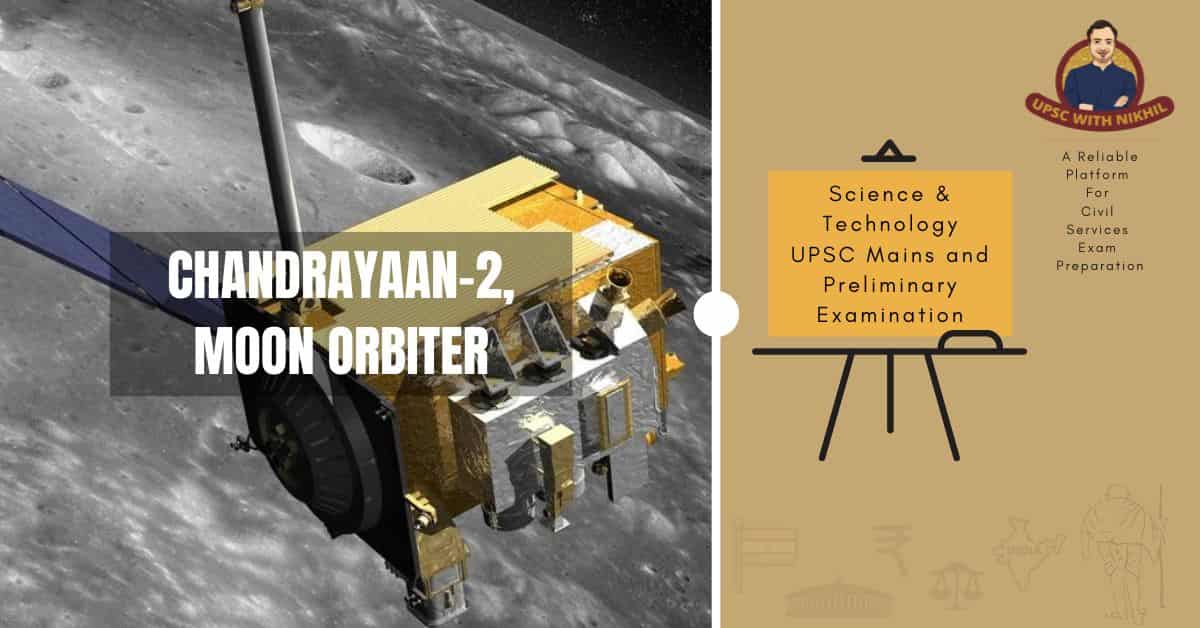Chandrayaan-2, Moon Orbiter
About Chandrayaan-2:
Indian spacecraft Chandrayaan-2 will deploy a lander, orbiter, and rover to the moon.
The orbiter will map the terrain of the Moon, looking into the elements and mineralogy of the surface, examining the lunar exosphere, and searching for signs of water ice.
In July 2019, all three vehicles launched together into lunar orbit, However, The lander carrying the rover made an unsuccessful attempt to settle in the southern hemisphere of the Moon. The orbiter keeps up its aerial observation of the Moon.
The Chandrayaan-1 orbiter, which launched in October 2008 and operated for 10 months, serves as the foundation for the project. Chandrayaan-2 has new technology and upgraded instrumentation designed for planetary missions in the future. While the lander and rover, were intended to last for one lunar day, had they landed successfully and the orbiter is expected to last for seven years.
Goals Of The Chandrayaan-2 Mission
Using upgraded instrumentation, the Chandrayaan-2 orbiter aims to expand on the data gathered during the Chandrayaan-1 mission. The Moon's topography will be mapped, and the elemental abundances and surface mineralogy will be studied, along with the lunar exosphere and the search for hydroxyl and water ice signals.
The lander was given the name Vikram in honor of India's first spaceflight pioneer, Vikram Sarabhai. At a latitude of roughly 70 degrees south, it would have touched down close to the Moon's South Pole.
Approximately 87 million dollars ($603 crore) was spent on the mission.
What Devices Is The Chandrayaan-2 Orbiter Equipped With?
1. (TMC 2) Terrain Mapping Camera,
TMC 2 is a scaled-down version of the Terrain Mapping Camera that was carried on the Chandrayaan 1 mission and used to produce a 3D map of the lunar surface. Its main goal is to study the lunar surface in the panchromatic spectral region (0.5-0.8 microns) from orbit with a high spatial resolution of 5 meters.
2. Chandrayaan 2 Large Area Soft X-ray Spectrometer (CLASS)
analyses the X-ray Fluorescence (XRF) spectra of the Moon to look for the presence of elements that make rocks, such as sodium, calcium, titanium, iron, and magnesium. By detecting the distinctive X-rays that these substances emit when energized by the Sun's beams, the XRF technique can identify these substances.
3.Solar X-ray Monitor (XSM) which Supports CLASS
by tracking the Sun's and its corona's X-ray emissions and determining the amount of solar radiation included in those rays. It also measures the entire solar X-ray spectrum in the 1–15 Kev energy range every second.
4. Orbiter High Resolution Camera (OHRC)
that generates DEMs (Digital Elevation Models) will be utilized to look for potential dangers by taking pictures of the landing site from two look angles. They will be used for additional scientific research after landing. Images from the OHRC have a resolution of 0.25 meters and cover a 12 x 3- kilometer area.
5. Synthetic Aperture Radar (SAR)
is an L- and S-band radar device used to analyze the thickness and electrical conductivity of the lunar regolith as well as to locate water ice inside permanently shadowed craters. It will be the first L-band radar mapper to orbit the Moon.
6. The Imaging Infrared Spectrometer (IIRS)
analyses and maps the distribution of molecular water and hydroxyl (OH) in the polar regions of the moon and will be able to detect light with wavelengths of 0.8 to 5 microns.
7. Chandra Atmospheric Composition Explorer 2 (Chace-2),
a neutral mass spectrometer which will collect samples of atoms from the thin atmosphere above the Moon's poles. The CHACE experiment from Chandrayaan 2 is expanded upon in CHACE 2.
8. The Dual Frequency Radio Science (DFRS)
experiment uses X-band (8496 MHz) and S-band (2240 MHz) transmissions that are broadcast to Earth-based receivers to examine the temporal development of electron density in the lunar ionosphere.



